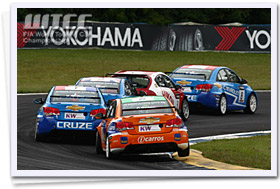The FIA World Touring Car Championship (WTCC) was launched in 2005. It is one of four world championships sanctioned by FIA and regarded as the top category of touring car sprint race series in the world.
Its basic event format consists of two 50km or 30 minute races per round. For 2011, the calendar initially had 12 rounds (24 races) but then the Moroccan round was cancelled later. At the time of writing - mid-March, a replacement round in Europe is under consideration.
Even though a round in the African continent was lost, the championship still tours around other continents, South America, Europe and Asia. It made the first visit to Japan in 2008 and has provided the opportunities to really feel the allures of WTCC for many motor sport fans in the country through the events at Okayama International Circuit for the last three years. From 2011, the Japanese round will move to Suzuka Circuit (the east short course) and the expectation for a good show at the new venue is already high.
WTCC is also known as a 'combat sport on race tracks' and its biggest appeal is the restless fierce battles shown everywhere on the track from start to finish, which explains the reason why the number of its followers has been growing so rapidly in Japan. Contact between cars is a part of life here but those aren't outrageous fights, so the spectators can enjoy the skillful race craft of world class drivers. You can closely watch superb technique of the drivers who always keep aggressive attitude, under certain rules and common sense. That's what makes WTCC so attractive.

Behind such entertaining races, there are the sporting regulations which are well thought out to facilitate close battles.
Firstly, there is the reversed grid system. It has been adopted for years to decide the starting grids of Race 2 but the system is now revised for the new season.
In the past, the top eight finishers of Race 1 were placed in reversed order on the starting grid for Race 2. Under this old system, however, the driver could deliberately back off in Race 1 to obtain a better grid position for Race 2.
To prevent this, the new system decides the grids for Race 2 by the result of the first section of qualifying session, giving the top ten qualifiers the first ten grids in reversed order. In the WTCC's qualifying format, all competitors run in the first section and then only ten fastest drivers are allowed to go on to the second section. And this final section decides the top ten grids for Race 1, in the same way as before, followed by other drivers who had knocked out at the end of first section. It should be very difficult for a driver to control his position in the sessions, aiming to sit on a good starting grid for the second race, as everyone tries to break into the top ten.